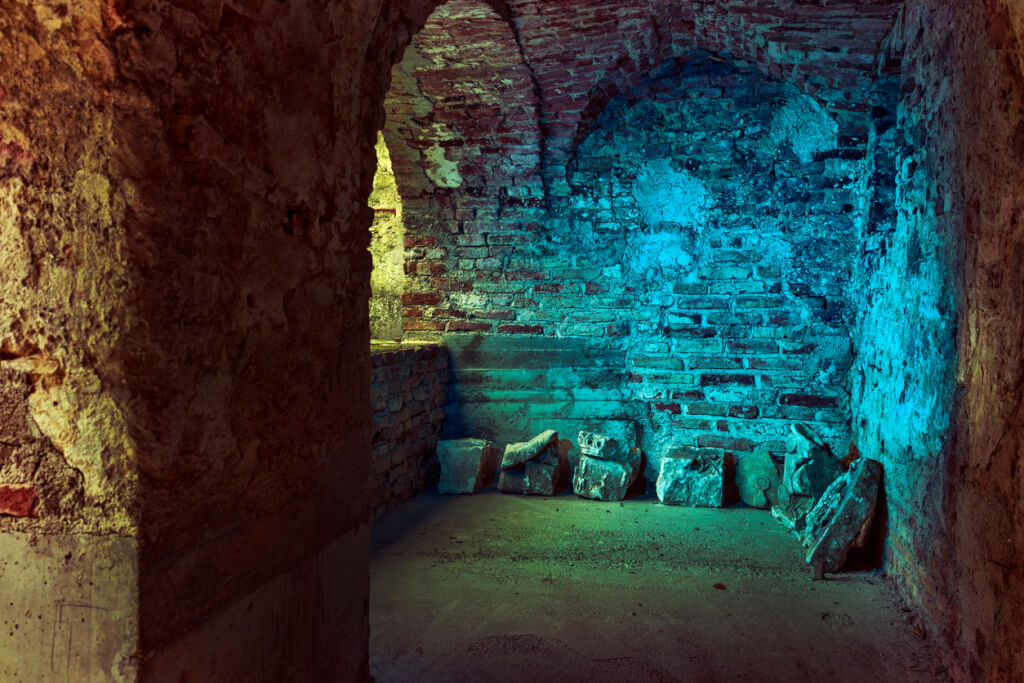Hundreds of people live in the tunnels under Las Vegas: this is a new kind of downshifting
We've all heard of Las Vegas, Nevada, the city of glittering neon, advertising and gambling. But he also has another life - a dungeon, which is called a small hell, in which about 1500 people live. How do they live there and why did they decide to do this, the publication found out with the BBC.

Photo: IStock
Rick, nightmares and a plan
“I’ll leave here soon, I’ll go somewhere far away. I’ll find a dark corner and disappear there,” says Rick.
And he says it in all seriousness.
Rick sits on the mattress and points his finger into the cave darkness, which cannot be overcome with a flashlight and which, if everything goes as he planned for himself, will someday finally swallow him forever.
“I’m not friends with people,” Rick admits. “Let everyone leave me alone.”
He is 72 and one of the oldest inhabitants of the "sin capital of the world". He says that for 35 years he has been coming back to life down here all the time.
Rick lists the problems that bother him here: rats "so big they'd scare anyone," cops and people—there are more and more of them.
“Well... bad dreams. I can’t get rid of them,” the man adds.
Nightmares come, according to Rick, from the past - he was once a military man. It was through dreams that he could not find a place for himself up there.
“I served in Vietnam. After three years in hell, I developed problems with my head,” explains the old man. He was eventually fired from his Marine unit for violating discipline by firing without permission.
On the subject: A huge spherical building was built in Las Vegas: its illumination fascinates with futurism
Later, in civilian life, he tried several jobs: “I worked in construction, opened the Rio casino and another one, New York, New York, made repairs, was a taxi driver... There was a time when I could work, but then life would plant another pig, and I would eventually leave work.”
Now he survives on the $23 he receives every month and alms. Rick cannot accept the fact that more and more people are looking for shelter in his tunnel.
“I was able to live here for so long because I knew all the residents well. And now some new ones have appeared, and I don’t find a common language with them... And I don’t find a common language with anyone... I’m a lone wolf,” he says.
Together with him, his old friend will go into the depths of the tunnels.
“This is Glenn. We’ve known each other for 15 years,” Rick explains. “Let’s go, let’s get lost!”
Lost identity
If you go deep into the tunnels, you can meet other inhabitants there.
“I’ll go out now. I want to polish up my boots a little,” says a voice from the depths.
The man's name is Jay. He welcomes visitors and even allows himself to be photographed.
“I even put on make-up,” he jokes.
He is “about 47 years old” and arrived in Las Vegas by bus at 14, from New Hampshire.
“Who would have thought that here my passport, my social security card, everything would be stolen right away, and I would be left with $27 in my pocket?” - he asks.
Jay says that despite his best efforts, over the years he has never been able to get an ID. Therefore, for nine years now, he has to live in the sewerage system of the city of sin.
This is an abridged version of his twisted story with many repetitions. Jay is chatty and hard to follow - almost as hard as looking away from his empty eye socket - his left. He lost an eye after being shot in the head.
“The story is so-so. If they told it to me, I wouldn’t believe it, because it doesn’t look like the truth. But this is the truth,” he states.
According to him, he differs from other underground residents of Las Vegas in that he no longer uses drugs, although he has tried everything in his time, and also in that he tries to remain optimistic, otherwise it is all a “waste of time and effort.”
In addition to the cardboard walls, he also owns a pillow and some blankets, a supermarket cart, several water bottles, two laundry baskets, soap, lime and a broom.
These belongings, plus the food he buys with the money from the scrap metal, help him survive in a place where, as Jay says, there are ghosts.
“Not like they show on TV in all sorts of programs. This is a different level of normality, some things can be rationally explained, but some cannot,” Jay tries to explain.
“For example, somewhere far away something will stir. A few years ago, such things happened here that no one dared to stay in this place after dark. Some terrible cruel things. I definitely saw something here... And it hunts, clings. I try not to pay attention and not to come into contact with it, because such things were here before me and will be here after me,” he says.
The journalists hand him a sandwich, a bag of essential hygiene items, and a McDonald's gift card.
Joe, light in the tunnel
In fact, the food for Jay was given by Joe Riordan.
The man with the bushy mustache and clear blue eyes was "two bad decisions away from being Jay or Rick" and now volunteers with Shine A Light, an organization that helps homeless people in the underworld.
“16 meters above us, people are spending $1000 on just one dinner,” he says, pointing to the ceiling.
The Jay and Rick Tunnel is located near the famous Caesar's Palace hotel and casino - many films were filmed here, Celine Dion and Elton John regularly stayed here.
One of the restaurants in his Piazza di Roma is Gordon Ramsay's Hell's Kitchen. There, a serving of twelve oysters can cost $56.
And in Bedford, whose owner is the no less famous Martha Stewart, prices are even higher. The restaurant is located near the Bellagio casino and charges from $109 for a steak and $1500 for a bottle of vintage 2008 Dom Pérignon pink champagne.
Last year, tourists spent $44,9 billion in Las Vegas on dining, hotel rooms, shopping, concerts, poker, roulette and other casino gambling. They do not even suspect that people live under their feet, eating sandwiches from benefactors and leftovers from garbage dumps.
The numbers are taken from the Las Vegas Assembly and Visitor Affairs Office's latest report released in April. The data show a huge gulf between the two worlds.
But these worlds are truly connected, says Matthew O'Brien, the first journalist to descend into the city's underground wilds and write about them. He once worked for a local magazine, Las Vegas City Life, and then wrote two books about the underworld: Under the Neon, Dark Days and Bright Nights. Surviving the Las Vegas Storm Drains" (Dark Days, Bright Nights: Surviving the Las Vegas Storm Drains).
“The tunnel inhabitants survive by eating scraps, Las Vegas surplus,” O'Brien explains. “They enter casinos and look for money lost or forgotten in machines, and beg from tourists.”
But this is not the end of the world.
“Of the people I interviewed, most were not homeless when they came to Las Vegas. They came to the city for the same reasons that I once did: looking for change, a new life, to fulfill their dreams,” says O’Brien.
He founded Shine the Light in 2009 as a community project.
“Some of them may not have been able to find a job, some have become addicted to gambling, to drugs that are so easy to get on the local streets, and now they end up under the same casinos for which they once came to this city in Nevada,” he concludes.
“Because Las Vegas, which never sleeps, is a magnet, but it’s also a homeless factory,” O’Brien concludes.
Robert and herd instinct
More than 6500 Las Vegas residents are homeless, according to city officials, and 65% of them sleep outside.
Organizations working with the homeless estimate that about 1500 people live in underground tunnels.
In November 2019, City Hall signed an executive order making sitting, resting, or wandering on sidewalks a misdemeanor punishable by up to 6 months in prison or a fine of up to $1000. Critics called these measures against the homeless "the most brutal in the area."
This decree came into force in February 2020, but before violators are fined or detained, they are asked to visit the “Corridor of Hope,” a street where organizations helping the homeless are located.
There, in the Courtyard of the Resource Center for the Homeless (a $20 million initiative), they can wash, eat, sleep, receive medical and psychological assistance, legal advice, and find work.
According to the city, 2021 people used these services in 6081, and an average of 371 people stayed in the expanded dormitories overnight.
Another program was added to this program, in which teams of representatives of different organizations work right on the streets.
“The city’s goal is not to arrest homeless people. Our goal is to work with them and help them be healthy, find a roof over their head and a job,” says the mayor’s speaker.
The support of the authorities of Las Vegas is only one of several jurisdictions in the metropolitan area that care for the homeless.
Shine the Light's outreach director Robert Bangart also went through what he calls the "corridor of despair" and lived underground for a while.
“I went down into the flood control tunnels at the invitation of one of my friends who spent the night there. Before that, I lived for years on the streets, where the situation is very unstable: sometimes some pathetic tourist will give you something to eat, sometimes you grab something yourself, but you never know where you will end up... Therefore, when I first went down, I felt something similar what I experience when I come home now,” he says.
And then he explains that we are talking about a “very primitive life on the verge of survival”, when only the satisfaction of the simplest needs is important: “I needed water, food and a dose.”
For a person in his situation, the tunnel really can be the easiest shelter: concrete walls and ceiling protect from the heat (in summer the temperature in the city rises to 40 degrees), as well as from strong winds from the Mojave Desert.
“Besides, no one can see you or bother you,” Robert adds, his words echoing what Rick and Jay said.
The tunnels are not guarded or patrolled. The Las Vegas City Police Department has confirmed that police officers are working with partner organizations that are responsible for warning these underground residents of the dangers of living in the tunnels, as well as providing homeless people with the opportunity to move into normal housing.
Robert after many years was able to take this step.
The turning point was an unpleasant incident: in the tunnels he was beaten by other homeless people.
“They attacked me and left me. From there they took me to the hospital and brought me back to life,” the man recalls.
There he met with the organization in which he now works. First he was a volunteer, and then he moved to a permanent position and is trying to help others to follow his example.
“We all have the so-called herd instinct, so our task is to build relationships with people,” says Robert.
Beverly and her community
An example of the herd instinct is Beverly, who lives in one of the tunnels.
She is a skinny blonde with weathered skin and a few missing teeth in her mouth.
Beverly tells us that she was born in Mississippi. Once I met a guy who invited her on a trip. How she got to Las Vegas, does not specify. She is now 44 and has lived in the tunnels for six years.
"So when are you going to leave here?" Robert asks her.
"Don't know. It is not so easy. I can only say that it’s definitely not today,” she said in response.
“Remember, we can help you. If you can handle it here, you can handle it anywhere,” adds Robert.
Beverly says she feels part of the community here.
“The first tunnel is especially active,” she says, nodding towards her neighbors hanging out a few meters away.
“Each of the tunnels is different from the other,” Robert explains after a while. — There are more organized ones, with a certain hierarchy, and there are very primitive ones. In some, residents even organized lighting, cleaned, brought furniture... You would be surprised if you got there.”
Steve's Cave
This is how they managed in the tunnel, which bears the name of Ali Baba. It is located in the industrial part of the city to the west. However, it is not Ali Baba who lives there, but a man named Steve.
At the entrance there is a table with chairs, an armchair and a barbecue. The rest of the room is covered with a black curtain.
A woman's voice from inside warns that no one invites us there.
You may be interested in: top New York news, stories of our immigrants and helpful tips about life in the Big Apple - read it all on ForumDaily New York
But behind the slightly tilted black curtain, you can see rugs laid on the floor, another table, a shelf with kitchen utensils and other items.
Steve, 57, stands up and, leaning on a walker, gives a tour of the courtyard of his underground home. He tells his own story, similar to the story of the other inhabitants of the tunnel, and at the same time - completely different.
His parents came to Las Vegas to realize their “great dream” - to open a casino. He grew up in such an environment, which eventually led him to alcohol and drugs.
For some time he lived on the streets of the city, and now he has been living here for six years.
“We came here to live a quiet life and hide from the world. Although even before they settled in the tunnel, they were invisible,” he says.
Rain and death
To talk to the inhabitants of the tunnels, you need to go down to the canal in front of the Rio casino, make your way between the stones and debris caused by water.
The tunnels were built to protect the city from floods. Winding labyrinths run from end to end under the valley, their task is to collect rainwater so that there is no flooding.
Rain falls rarely in this arid city, which once grew in the middle of the Mojave Desert - only about 10 centimeters per year. But when it starts, it pours mercilessly.
The most powerful showers occur between July and September, so during the monsoon season it is dangerous to live in underground tunnels.
“Even when it's not raining, flood control structures are no fun,” the Clark County Regional Flood Control Office posted a warning on its website. This is the organization responsible for maintaining and expanding flood control infrastructure: canals, sumps and hundreds of kilometers of drains. — Water can come through the canals at any time. The current speed reaches 50 kilometers per hour, so if the water height is only 15 centimeters, it will knock you off your feet.”
This has happened more than once.
On August 13, 2022, after one of the heaviest showers of that rainy season (the most full-flowing in several decades), firefighters failed to save a man who was washed away by a stream of water.
And then, while clearing debris from the canal under the Strip - the famous 6,4-kilometer stretch of Las Vegas Boulevard, where casinos and luxury resorts are located - they found another corpse.
A few nights before, on July 29, firefighters had to rescue seven people from the flood in less than three hours.
In his three decades of living in the labyrinths of wastewater treatment plants, Rick had to see several such episodes with his own eyes.
“I saw the water almost reach the ceiling,” he recalls.
Rick recalled a time when he tried to help some people, and as a result they had to pull him out. Or another one: the woman tried to cross the bottom of the canal through the water, but could not.
“We all screamed. She had a baby on her back and she couldn't cross. Both died. How can you forget that?" Rick says regretfully.
Read also on ForumDaily:
Homes built from hemp in Britain: why you might want one too
Cheap places to live in the 10 most expensive states in America
Former FBI Agent Reveals XNUMX Communication Secrets That Will Help You in Everyday Life
Scientists make cancer cells commit 'suicide': this is the future of cancer treatment
The couple moved into a van to save money, but gas and parking costs were higher than expected
Subscribe to ForumDaily on Google NewsDo you want more important and interesting news about life in the USA and immigration to America? — support us donate! Also subscribe to our page Facebook. Select the “Priority in display” option and read us first. Also, don't forget to subscribe to our РєР ° РЅР ° Р »РІ Telegram and Instagram- there is a lot of interesting things there. And join thousands of readers ForumDaily New York — there you will find a lot of interesting and positive information about life in the metropolis.












